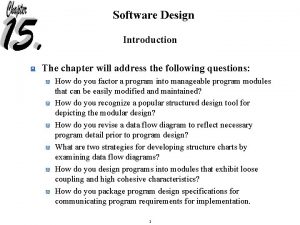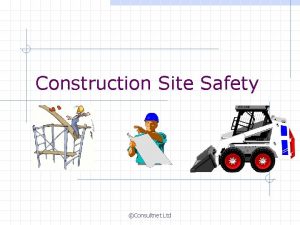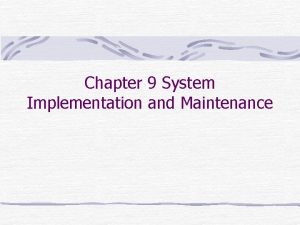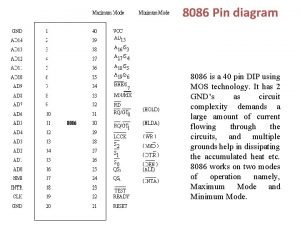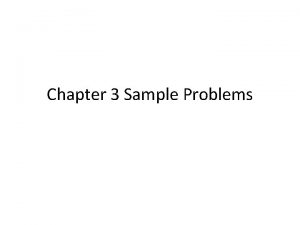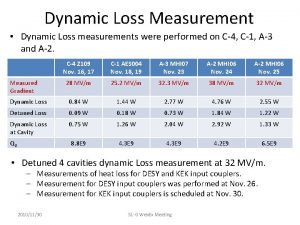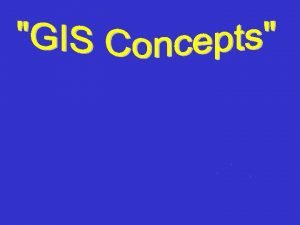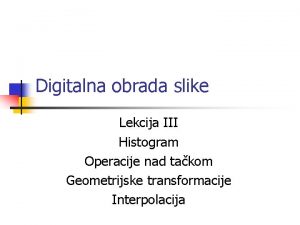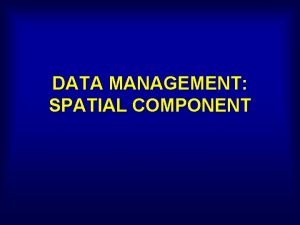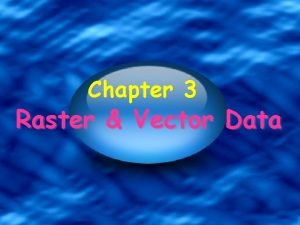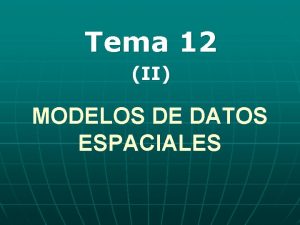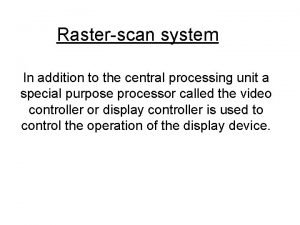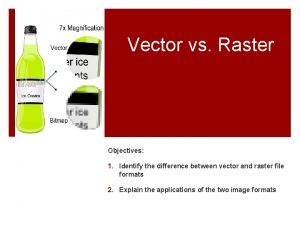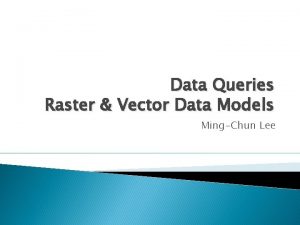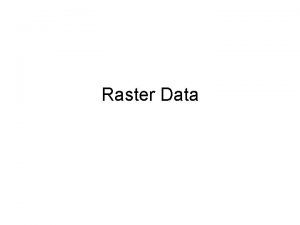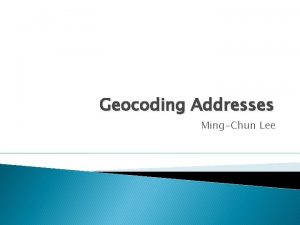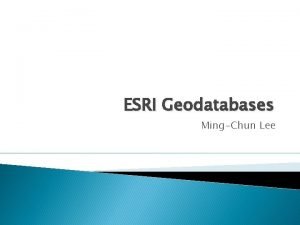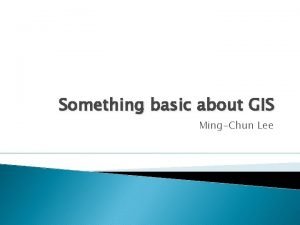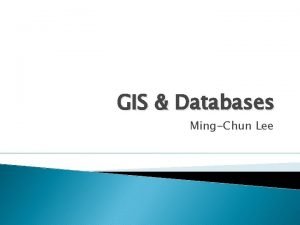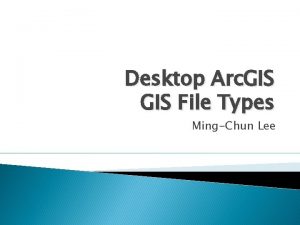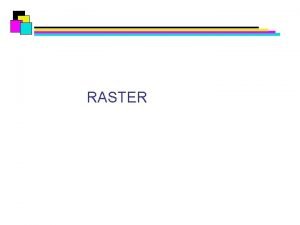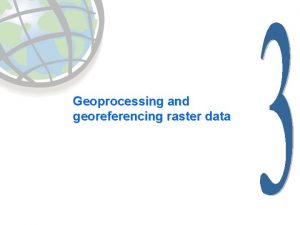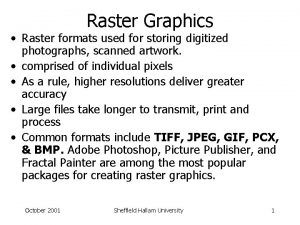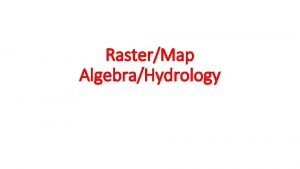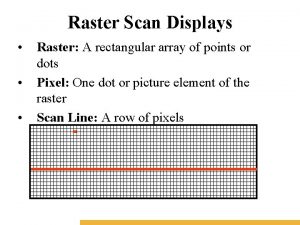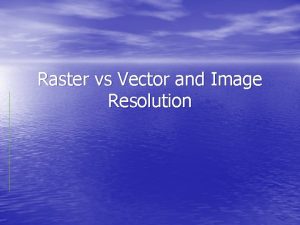Raster Analysis MingChun Lee 1 Raster Analysis Performed























































- Slides: 55

Raster Analysis Ming-Chun Lee 1

Raster Analysis Performed on cells and grids. Raster cells store data ◦ Nominal – land use ◦ Ordinal – street classification ◦ Interval/Ratio – temperature, elevation manipulations on cell values for a single raster layer or multiple layers. Perform analysis based on 2

Why use Raster GIS Raster is better suited for spatially continuous data ◦ Elevations, p. H, air pressure, temperature, salinity Raster is better for creating visualizations and modeling environmental phenomena Raster data is a simplified realization of the world, and allows for fast and efficient processing 3

Map Algebra Cell by Cell combination of raster data layers using mathematical operations ◦ one layer ◦ multiple layers Each number represents a value at a raster cell location Simple operations can be applied to each number Raster layers may be combined through operations ◦ Addition, subtraction and multiplication 4

Map Algebra 5

Map Algebra 4 1 5 2 3 1 1 3 4 6 13 7 6 10 5 8 5 + Input 2 3 2 7 7 2 4 7 4 6 6 Input 1 6 3 4 2 3 6 2 3 4 4 1 2 7 6 2 2 3 6 5 5 = Output 10 6

Map Algebra The computer will allow you to perform virtually any mathematical calculation ◦ beware: some will make sense, others won’t. For example, water = 0, land = 1. Then, you can multiply this grid with an elevation map. The output will include 0’s where water existed (x * 0 = 0), and the original elevation value where land existed (x * 1 = x) Or, you can add the elevations and the grid with 0’s and 1’s together (but, it would be meaningless!) 7

Map Algebra Grid 1 * Grid 2 = Grid 3 Grid 1 1 Grid 3 Grid 2 0 * = 0 8

Map Algebra Multiple grid themes share the same X, Y coordinate space A single output grid theme is the result of the multiple grids 9

Map Algebra Mathematical Operators: ◦ Arithmetic +, -, *, / ◦ Boolean AND, OR, NOT, XOR ◦ Relational =, <, >, ≤, ≥, <> ◦ Algebraic Functions Powers & Roots, Trigonometry, Logarithm 10

Mathematical Operator: Arithmetic 11

Mathematical Operator: Boolean 12

Mathematical Operator: Relational 13

Mathematical Operator: Algebraic Functions 14

Scope of Computations Local Functions Focal/Neighborhood Functions Zonal Functions Global Functions ◦ Process cells on a cell-by-cell basis. ◦ only use data in a single cell to calculate an output value ◦ Process data for each pixel using the attribute values of the neighboring cells of that pixel. ◦ Process cells on the basis of zones. ◦ Process data at each pixel on the output grid using entire source grid. 15

Local Functions 5 7 4 25 49 16 input output = sqr(input) 16

Local Functions Operations that modify a cell on a single grid ◦ Data type changes ◦ Arithmetic operations ◦ Converting one value to another according to a rule (Recode) Local operations on multiple layers ◦ Map algebra (Output = f(Input 1, Input 2, …) Functions may be mathematical or logical 17

Local Functions Single grid Multiple grid (addition) 18

Focal/Neighborhood Functions 5 7 4 input 11 16 output = focalsum(input) 19

Focal/Neighborhood Functions Moving window ◦ Assigns the value of a neighborhood of grid cells to one particular grid cell (kernel) ◦ Useful for calculating local statistical functions 20

Neighborhood Functions 21

Zonal Functions 5 7 4 input Zone 2 zone Zone 1 output = zonalsum(zone, input) 9 7 9 9 7 7 Zone 1 2 Sum 9 7 22

Zonal Functions Output value at each location depends on the values of all the input cells in an input value grid that shares the same input value zone Type of complex neighborhood function ◦ use complex neighborhoods or zones 23

input 535. 54 766. 62 Input_zone 127 6280 160 10800 24

Global Functions 5 7 input 4 6 7 5 6 4 4 8 7 5 5 9 8 6 6 7 output = trend(input) 6 25

Global Functions Output value of each location is potentially a function of all the cells in the input grid ◦ e. g. distance functions, surfaces, interpolation, etc. 26

Distance to Features Cell value is the Distance from the Cell Center to the Nearest Feature(s) in a Specified Layer ◦ Physical distance– equivalent to buffers ◦ Cost distance Requires a cost grid as input Cost grid contains costs for unit distance Cost distance between two cells is the average of the two values multiplied by the distance between them Total cost is calculated to source cells. 27

Distance to Features 28

Interpolation Between Features Interpolation predicts values for cells in a raster from a limited number of sample data points. ◦ Elevation, rainfall, chemical concentration, noise level Average of Nearby Features’ Values, Weighted by Distance, Regardless of Density Example: Number of Bus Routes Serving a Neighborhood! 29

Interpolation Between Features 30

Density of Features Value Assigned Based on the Neighborhood Density of a Feature Can be Weighted on an Attribute Value ◦ Example: Estimate a Population Density Surface Using Census Tract Population ◦ Another Example – Bus Service Density 31

Density of Features 32

Spatial Analyst functions Find Distance Calculate Density Interpolate Surface Derive Slope, Aspect Create Contour Cell Statistics Summarize Zones Tabulate Areas Map Query, Calculator Neighborhood Statistics Reclassify 33

Raster-based Analysis Finding potential sites for a new school Criteria: (ESRI: Using Arc. GIS Spatial Analyst) ◦ ◦ On flat land Near recreation sites Away from existing schools Land use in terms of cost Agricultural – cheapest Barren land Brush/Transitional Forest Built up – most expensive 34

Slope 35

Slope 36

Distance 37

Distance 38

Reclassify 39

Reclassify 40

Reclassify 41

Reclassify Lecture 9 42

Weighting and Combining Datasets Weights: ◦ ◦ Dist to Rec_sites: 0. 5 Dist to schools: 0. 25 Landuse: 0. 125 Slope: 0. 125 43

Raster Calculation 44

Raster Calculation 45

Result 46

Finding an Access Road to New Sites 47

Cost Layer Slope: ◦ High values (10) to steeper slopes Land Use: ◦ ◦ ◦ Agricultural: 4 Brush/Transitional: 5 Barren land: 6 Forest: 8 Built up: 9 Water: 10 48

Cost Layer 49

Cost Layer 50

Cost Weighted Distance 51

Cost Weighted Distance 52

Shortest Path 53

Shortest Path 54

Shortest Path 55
 Primary tool used in structured design is
Primary tool used in structured design is Annabel lee tpcastt
Annabel lee tpcastt Tinikling formation
Tinikling formation What important mission was performed by the hebrew midwives
What important mission was performed by the hebrew midwives No job is so important that it cannot be performed safely
No job is so important that it cannot be performed safely Provider performed microscopy
Provider performed microscopy Mandolin philippines
Mandolin philippines Greek theater history
Greek theater history Francois vatel period it was created and performed
Francois vatel period it was created and performed No job is so important that it cannot be performed safely
No job is so important that it cannot be performed safely System maintenance must be performed to
System maintenance must be performed to Plicatured nail treatment
Plicatured nail treatment Antigone's family tree answer key
Antigone's family tree answer key 40 pins of 8086 microprocessor
40 pins of 8086 microprocessor What is the size separation
What is the size separation What is region filling in computer graphics
What is region filling in computer graphics In self sealability test dye used for colour is
In self sealability test dye used for colour is Possibly synoynm
Possibly synoynm A & d window cleaning performed $450 of services
A & d window cleaning performed $450 of services Steps of subjective refraction
Steps of subjective refraction Jesus performed many other signs
Jesus performed many other signs Jesus performed many other signs
Jesus performed many other signs Objectives about work immersion
Objectives about work immersion Quadrant streak
Quadrant streak Dynamic loss
Dynamic loss 2) greek dramas were originally performed ____.
2) greek dramas were originally performed ____. Tasks performed by computer forensics tools
Tasks performed by computer forensics tools Tasks performed by computer forensics tools
Tasks performed by computer forensics tools Guerin bending process.
Guerin bending process. What are the 7 miracles jesus performed
What are the 7 miracles jesus performed Dvst stands for in computer graphics
Dvst stands for in computer graphics Fm raster
Fm raster Raster id
Raster id Contoh perangkat lunak menggambar adalah
Contoh perangkat lunak menggambar adalah Random scan display processor
Random scan display processor Cathode ray tube in computer graphics
Cathode ray tube in computer graphics What is raster and vector data in gis
What is raster and vector data in gis Pravougaoni raster
Pravougaoni raster Digitalna obrada slike
Digitalna obrada slike Raster vs vector data
Raster vs vector data Jelaskan penggabungan gambar vektor dengan gambar vektor
Jelaskan penggabungan gambar vektor dengan gambar vektor Raster scan display system
Raster scan display system Vector vs raster data
Vector vs raster data Raster graphics algorithms
Raster graphics algorithms Define computer animation
Define computer animation Modelo raster
Modelo raster Raster scan display processor
Raster scan display processor Character generation methods in computer graphics
Character generation methods in computer graphics What does raster mean
What does raster mean Digital raster graphic
Digital raster graphic Didaktisches raster
Didaktisches raster Programming raster display system in computer graphics
Programming raster display system in computer graphics Detaljhandelsavtalet
Detaljhandelsavtalet Architecture of raster scan display
Architecture of raster scan display Rasterization adalah
Rasterization adalah Is stroke a raster or vector image
Is stroke a raster or vector image
